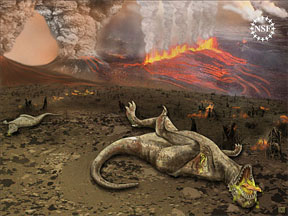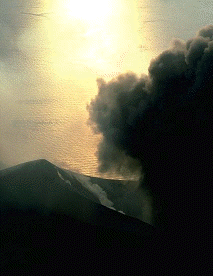Click on image for full size
Courtesy of NSF
K-T Extinction (Why Did the Dinosaurs Go Extinct?)
Why did the dinosaurs go extinct? No one knows for sure, and scientists have come up with a number of theories to explain why the dinosaurs suddenly died out about 65 million years ago.The most prominent theories about the cause(s) of the dinosaurs’ demise are based on the fact that scientific evidence shows us that at the time the dinosaurs died out, the Earth experienced increased volcanism as well as a number of major collisions with asteroids or comets. This extinction event is referred to as the the Cretaceous-Tertiary Mass Extinction or the K-T Extinction (because it marks the boundary between the Cretaceous Period, which is often abbreviated with the letter K, and the Tertiary Period), and it wasn't just the dinosaurs that went extinct--roughly two thirds of all of the plant and animal species on Earth disappeared.
Most scientists believe that increased volcanic activity may have introduced dust particles into the atmosphere, causing a drop in photosynthesis (and plant growth). This would have weakened the Earth’s ability to support the ecosystems that thrived in the Cretaceous Period, and scientists believe that the problem was made much worse when one or more large asteroids impacted the Earth, throwing a massive cloud of dust and toxic chemicals like sulfuric acid into the atmosphere. It is commonly thought that this event poisoned the Earth’s atmosphere for years, making plant and plankton growth impossible and fatally disrupting food chains worldwide.
There are other factors that may have contributed to the dinosaurs’ extinction. For instance, during the Cretaceous Period, we know that the oxygen levels in the Earth’s atmosphere were much higher than today. This means that when a large asteroid impacted the Earth, there could have been large firestorms, which would have caused a temporarily increased greenhouse effect that could have killed off a large number of organisms. There is also evidence to suggest that the Earth’s sea levels dropped significantly during the K-T boundary, and although no one knows exactly what caused this, we can see that this could have caused widespread climate changes and contributed to the dinosaurs’ extinction as well.
There are other theories that are less widely accepted; for instance, some scientists believe that the dinosaurs went extinct because mammals became very good at eating the dinosaurs’ eggs. Others believe that there was a supernova explosion near Earth, and the radiation from this explosion poisoned the majority of life on Earth. No one knows for sure the reason the dinosaurs died out - it is a source of scientific debate. There are many scientists around the world still conducting research in order to test different theories and answer this question.









